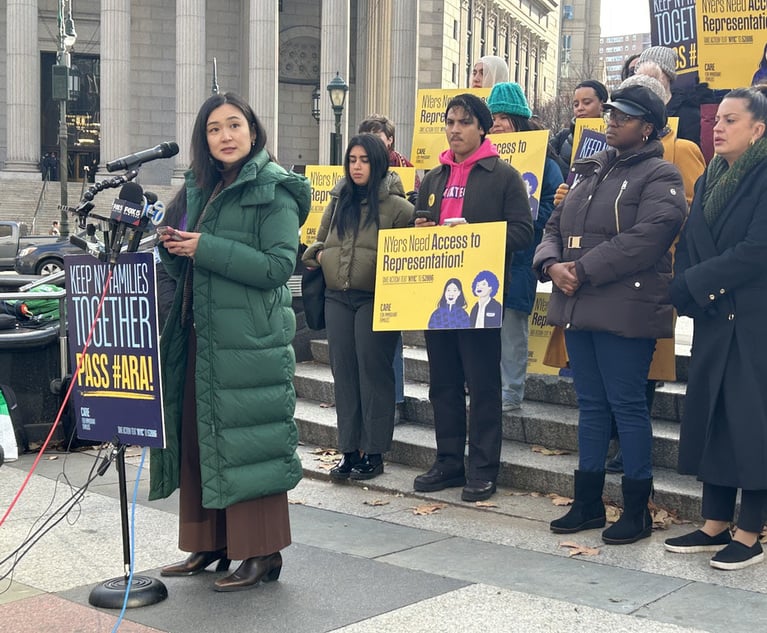EPA Prepared to Defend Against Lawsuit From NY Over Hudson River Cleanup, Official Says
A regional official from the EPA said Thursday morning he expects their decision, which requires no additional dredging, for now, of the upper Hudson River, will stand up in court.
April 11, 2019 at 01:32 PM
7 minute read
 Gov. Andrew Cuomo (Photo: Shutterstock)
Gov. Andrew Cuomo (Photo: Shutterstock)
New York state will sue the U.S. Environmental Protection Agency after a regional federal official announced Thursday morning that General Electric had completed, at least for now, the terms of an agreement with the agency to dredge the Hudson River for contaminants.
Gov. Andrew Cuomo and Attorney General Letitia James announced the lawsuit in a joint press release after the EPA issued its decision Thursday morning, saying the federal agency should require GE to continue its cleanup of the Hudson River.
“Since the EPA has failed to hold GE accountable for fulfilling its obligation to restore the river, New York State will take any action necessary to protect our waterways and that includes suing the EPA to demand a full and complete remediation,” Cuomo said. “Anything less is unacceptable.”
James said that, despite findings from the EPA that GE had fulfilled its legal obligations related to the cleanup, the Hudson River still required remedial action from the company. GE has worked with the EPA in recent decades to clear a portion of the upper Hudson River of PCBs, which the company used and disposed of into the waterway for nearly three decades until the 1970s.
“Despite the EPA's stance, the facts remain crystal clear: the cleanup of PCBs is incomplete, and allowing GE to walk away without accountability is dangerous to the health and wellness of New Yorkers,” James said.
A regional official from the EPA said Thursday morning he expects their decision, which requires no additional dredging, for now, of the upper Hudson River, will stand up in court. GE will still be on the hook to monitor the river for several decades and take additional remedial action, if needed.
EPA Regional Administrator Peter Lopez said on a conference call with reporters that the agency was legally required to issue the certificate to GE under a consent agreement with the company from 2006.
“Our goal is to make sure we're making the right decision based on science and the law and based on review from our counsel we feel that we are legally bound to issue a certification and it's okay if it's tested in the courts,” Lopez said. “That's part of our Democratic process, and I respect the governor and our colleagues.”
Lopez cautioned that there has been some confusion over what the certificate issued to GE represents. It does not void the company from any future liability concerning cleanup of any portion of the Hudson River, Lopez said.
Instead, he said, the certificate means that GE has completed its work dredging the part of the upper Hudson River it agreed to clean up in the 2006 legal agreement with the EPA. That work stopped in 2015. Under the terms of that contract, Lopez said, the agency was obligated to issue the certificate to GE.
“We respect the governor, we respect the passion of our colleagues. We have some level of disagreement on the understanding of the consent decree and the law surrounding our decision. I can't say we're afraid, all I can say is that we respect their ability to question, and that's okay,” Lopez said. “If they do advance that, we're respecting it will lend itself to greater clarity as we move forward.”
It's actually the second of three certificates that are expected to be issued to GE over time. The third—which would finally void GE of any future liability concerning contamination of the Hudson River—isn't expected to be issued to the company for more than five decades, according to the EPA.
In the intervening years, of which there will be many, GE will be responsible for monitoring levels of contaminants in the upper Hudson River and may be required to perform additional dredging, if the EPA deems it necessary. The federal agency included a provision in the 2006 legal arrangement with GE that allows it to reopen the site for additional remedial work.
That could include remedial action for other portions of the Hudson River, which environmental advocates and state officials have urged as part of a greater cleanup project. They've argued that the contaminants have traveled beyond the 40-mile stretch GE was charged with dredging and have called on the company to perform similar work in those areas.
There was also a provision included that will prohibit the EPA from suing GE over the upper Hudson River, so long as the company continues to uphold its end of the bargain in monitoring and performing additional remedial activities, if ordered. The covenant not to sue was triggered when the agency issued the certificate on Thursday.
That provision does not preclude GE from litigation involving other portions of the Hudson River, including the lower Hudson and the floodplains, according to the EPA.
GE said in a statement after the EPA issued the certificate that the company is committed to continue monitoring of the river but that the decision largely affirmed their work in recent decades. The company spent roughly $1.7 billion on the cleanup, which removed more than 300,000 pounds of PCBs from the river.
“Today's decision by the U.S. Environmental Protection Agency confirms GE successfully completed the Hudson River dredging project. EPA concluded that the dredging project was effective in reducing PCB levels and said these declines are expected to continue,” GE said in a statement. “GE will continue to collect environmental data to assess ongoing improvements in river conditions and to work closely with EPA, New York State and local communities on other Hudson environmental projects.”
Recent testing by the federal agency found that GE had met its standards for the project in more than 99 percent of sediment samples taken by New York in recent years. The EPA also said there were no longer any areas of the upper Hudson River with extreme concentrations of PCBs, though there are still areas with relatively higher levels.
But the EPA did not go so far as to clear the river as protective of human health and the environment as a result of the remediation, the agency said. It issued a five-year review of the remedy along with the certificate on Thursday that said it decided to defer a determination of the so-called protectiveness until more data from fish tissue is gathered in the river. That will likely take several years.
The New York State Department of Environmental Conservation came out against the EPA's decision on Thursday, saying that its testing showed significant concentrations of PCBs remain in the upper Hudson and that the remedial work done by GE has not reduced PCB levels in the lower Hudson.
“EPA is obligated to direct GE to meet the cleanup goals set when the dredging remedy was selected,” said DEC Commissioner Basil Seggos. “The federal government's failure to protect New York's environment and New Yorkers is unacceptable, and we are doing what we must to compel EPA and GE to finish the job and protect public health, the precious and irreplaceable Hudson River environment, and the communities that depend on a clean and healthy river.”
READ MORE:
Cuomo Threatens Lawsuit Against EPA Over Hudson River Cleanup
NY AG James Leads Coalition in Interstate Smog Lawsuit Against US EPA
Federal Judge Strikes Down Trump Administration's Census Citizenship Question
This content has been archived. It is available through our partners, LexisNexis® and Bloomberg Law.
To view this content, please continue to their sites.
Not a Lexis Subscriber?
Subscribe Now
Not a Bloomberg Law Subscriber?
Subscribe Now
NOT FOR REPRINT
© 2025 ALM Global, LLC, All Rights Reserved. Request academic re-use from www.copyright.com. All other uses, submit a request to [email protected]. For more information visit Asset & Logo Licensing.
You Might Like
View All
So Who Won? Congestion Pricing Ruling Leaves Both Sides Claiming Victory, Attorneys Seeking Clarification
4 minute read
Hochul Vetoes 'Grieving Families' Bill, Faulting a Lack of Changes to Suit Her Concerns

Court System Names New Administrative Judges for New York City Courts in Leadership Shakeup
3 minute read
Trending Stories
- 1'It's Not Going to Be Pretty': PayPal, Capital One Face Novel Class Actions Over 'Poaching' Commissions Owed Influencers
- 211th Circuit Rejects Trump's Emergency Request as DOJ Prepares to Release Special Counsel's Final Report
- 3Supreme Court Takes Up Challenge to ACA Task Force
- 4'Tragedy of Unspeakable Proportions:' Could Edison, DWP, Face Lawsuits Over LA Wildfires?
- 5Meta Pulls Plug on DEI Programs
Who Got The Work
Michael G. Bongiorno, Andrew Scott Dulberg and Elizabeth E. Driscoll from Wilmer Cutler Pickering Hale and Dorr have stepped in to represent Symbotic Inc., an A.I.-enabled technology platform that focuses on increasing supply chain efficiency, and other defendants in a pending shareholder derivative lawsuit. The case, filed Oct. 2 in Massachusetts District Court by the Brown Law Firm on behalf of Stephen Austen, accuses certain officers and directors of misleading investors in regard to Symbotic's potential for margin growth by failing to disclose that the company was not equipped to timely deploy its systems or manage expenses through project delays. The case, assigned to U.S. District Judge Nathaniel M. Gorton, is 1:24-cv-12522, Austen v. Cohen et al.
Who Got The Work
Edmund Polubinski and Marie Killmond of Davis Polk & Wardwell have entered appearances for data platform software development company MongoDB and other defendants in a pending shareholder derivative lawsuit. The action, filed Oct. 7 in New York Southern District Court by the Brown Law Firm, accuses the company's directors and/or officers of falsely expressing confidence in the company’s restructuring of its sales incentive plan and downplaying the severity of decreases in its upfront commitments. The case is 1:24-cv-07594, Roy v. Ittycheria et al.
Who Got The Work
Amy O. Bruchs and Kurt F. Ellison of Michael Best & Friedrich have entered appearances for Epic Systems Corp. in a pending employment discrimination lawsuit. The suit was filed Sept. 7 in Wisconsin Western District Court by Levine Eisberner LLC and Siri & Glimstad on behalf of a project manager who claims that he was wrongfully terminated after applying for a religious exemption to the defendant's COVID-19 vaccine mandate. The case, assigned to U.S. Magistrate Judge Anita Marie Boor, is 3:24-cv-00630, Secker, Nathan v. Epic Systems Corporation.
Who Got The Work
David X. Sullivan, Thomas J. Finn and Gregory A. Hall from McCarter & English have entered appearances for Sunrun Installation Services in a pending civil rights lawsuit. The complaint was filed Sept. 4 in Connecticut District Court by attorney Robert M. Berke on behalf of former employee George Edward Steins, who was arrested and charged with employing an unregistered home improvement salesperson. The complaint alleges that had Sunrun informed the Connecticut Department of Consumer Protection that the plaintiff's employment had ended in 2017 and that he no longer held Sunrun's home improvement contractor license, he would not have been hit with charges, which were dismissed in May 2024. The case, assigned to U.S. District Judge Jeffrey A. Meyer, is 3:24-cv-01423, Steins v. Sunrun, Inc. et al.
Who Got The Work
Greenberg Traurig shareholder Joshua L. Raskin has entered an appearance for boohoo.com UK Ltd. in a pending patent infringement lawsuit. The suit, filed Sept. 3 in Texas Eastern District Court by Rozier Hardt McDonough on behalf of Alto Dynamics, asserts five patents related to an online shopping platform. The case, assigned to U.S. District Judge Rodney Gilstrap, is 2:24-cv-00719, Alto Dynamics, LLC v. boohoo.com UK Limited.
Featured Firms
Law Offices of Gary Martin Hays & Associates, P.C.
(470) 294-1674
Law Offices of Mark E. Salomone
(857) 444-6468
Smith & Hassler
(713) 739-1250






